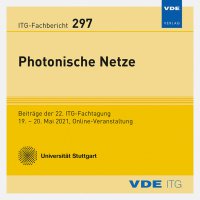S-Band Transmission with Off-the-Shelf C-Band Components Enabled by Nonlinear Predistortion based on Coherent System Identification
Conference: Photonische Netze - 22. ITG-Fachtagung
05/19/2021 - 05/20/2021 at Online
Proceedings: ITG-Fb. 297: Photonische Netze
Pages: 7Language: englishTyp: PDF
Authors:
Emmerich, Robert; Sena, Matheus; Erkılınc, M. Sezer; Sackey, Isaac; Elschner, Robert; Schmidt-Langhorst, Carsten; Schubert, Colja; Freund, Ronald (Fraunhofer Institute for Telecommunications, Heinrich-Hertz-Institute, Berlin, Germany)
Abstract:
In order to cope with the rapid traffic growth while at the same time reducing the cost-per-bit, one of the main objectives for operators is the efficient reuse of the legacy optical fiber infrastructure. This is highly desirable as fibers represent a valuable asset in the network. To achieve this objective, multiband (MB) or ultra-wideband (UWB) dense wavelength division multiplexing, in combination with higherorder modulation formats and high symbol rates, may be a desirable option from a techno-economic standpoint as the short- to mid-term solution for capacity upgrades. In this contribution, we experimentally investigate the feasibility of S-band transmission over 40 km single mode fiber (SMF) with 64-GBd dual-polarization (DP) 64- and 32-ary quadratureamplitude modulation (QAM) using off-the-shelf C-band components such as DP-IQ modulator and coherent receiver. Since these components are not optimized for an out-of-band use, mitigation of the associated optical signal to noise ratio (OSNR) penalty is critical to achieve similar performance as in the wavelength band they are designed for. To achieve such an OSNR penalty reduction, we perform a Volterra-based coherent system identification (SI) method in conjunction with nonlinear digital predistortion (NLPD) in the S-band. In order to enable transmission, two different approaches for SI and NLPD are studied. A per wavelength approach is compared to a single wavelength method concerning complexity and system performance over the S-band (1470 - 1530 nm) in back-to-back (b2b) and 40 km transmission scenarios. For the later method, additional b2b characterizations are carried out at 1500 nm and 1550 nm. Comparing the achievable Q-factors at maximum OSNR for these two wavelengths, we observe a δ of 0.7 dB for DP-64QAM. Furthermore, the proposed SI+NLPD method enables 40 km transmission for 1470 – 1530 nm with a Q2-factor above the soft-decision and hard-decision forwarderror correction thresholds for DP-64QAM and DP-32QAM, respectively.


